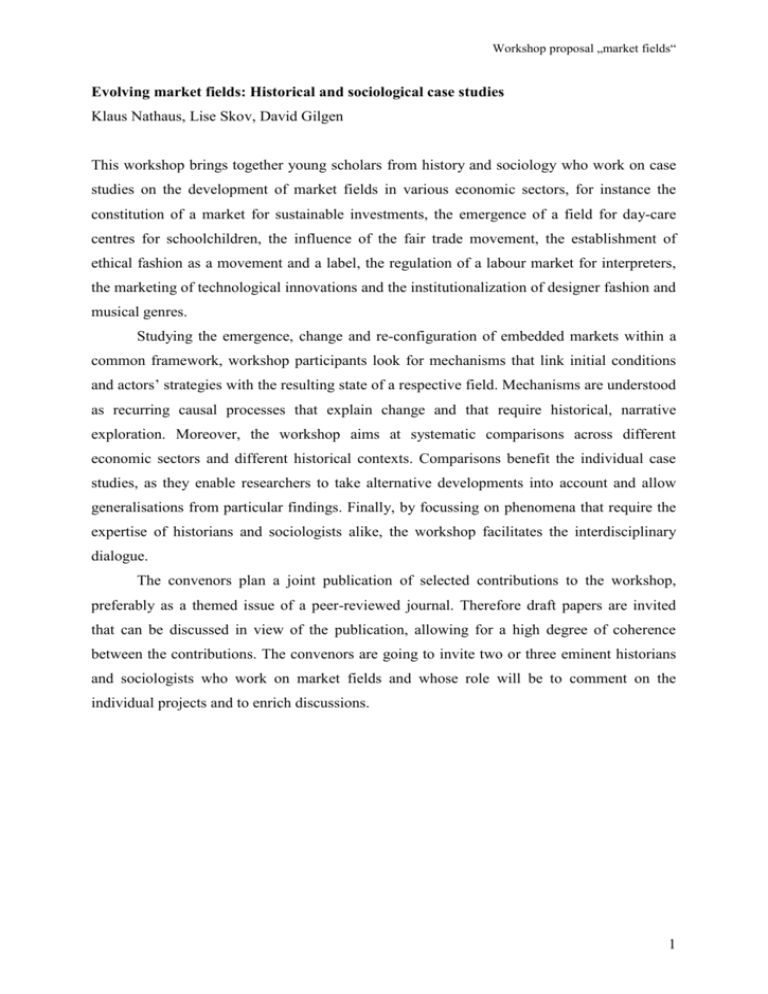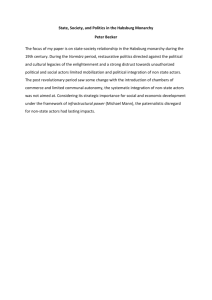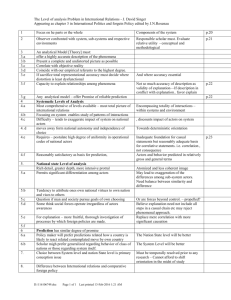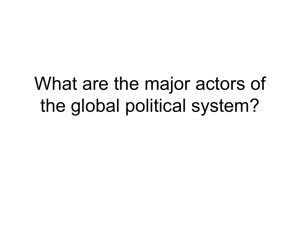The Emergence of Markets / Fields - Uni
advertisement

Workshop proposal „market fields“ Evolving market fields: Historical and sociological case studies Klaus Nathaus, Lise Skov, David Gilgen This workshop brings together young scholars from history and sociology who work on case studies on the development of market fields in various economic sectors, for instance the constitution of a market for sustainable investments, the emergence of a field for day-care centres for schoolchildren, the influence of the fair trade movement, the establishment of ethical fashion as a movement and a label, the regulation of a labour market for interpreters, the marketing of technological innovations and the institutionalization of designer fashion and musical genres. Studying the emergence, change and re-configuration of embedded markets within a common framework, workshop participants look for mechanisms that link initial conditions and actors’ strategies with the resulting state of a respective field. Mechanisms are understood as recurring causal processes that explain change and that require historical, narrative exploration. Moreover, the workshop aims at systematic comparisons across different economic sectors and different historical contexts. Comparisons benefit the individual case studies, as they enable researchers to take alternative developments into account and allow generalisations from particular findings. Finally, by focussing on phenomena that require the expertise of historians and sociologists alike, the workshop facilitates the interdisciplinary dialogue. The convenors plan a joint publication of selected contributions to the workshop, preferably as a themed issue of a peer-reviewed journal. Therefore draft papers are invited that can be discussed in view of the publication, allowing for a high degree of coherence between the contributions. The convenors are going to invite two or three eminent historians and sociologists who work on market fields and whose role will be to comment on the individual projects and to enrich discussions. 1 Workshop proposal „market fields“ Comparing empirical studies on evolving market fields: A suggested frame of reference The following considerations suggest a common frame of reference to facilitate comparisons and the interdisciplinary dialogue between historians and sociologists. The first part outlines a model of market fields that accounts for the role of social networks, institutions and cognitive frameworks in their change and reproduction. The second part points out foci for empirical studies and presents some guiding questions for individual studies. What are market fields and how do they change? Economic sociology since the 1980s is marked by an increasing awareness of the many ways in which economic behaviour is embedded in diverse social structures. In order to analyse economic phenomena in general and markets in particular, sociological studies generally refer to three structuring social forces: networks, institutions of cognitive frameworks.1 Networks are social relations between market actors (producers, consumers, suppliers, regulators, workers) that enable them to act under uncertainty. Networks promise to generate trust, facilitate the exchange of information or reduce risk, but may also be misused by fraudsters. Compared with arms-length ties that are founded solely on cost calculation, network relations are closer, fewer and based on the expectation of reciprocity. Networks can be personal and organisational. They are manifested, established and reproduced in informal meetings of business people, in negotiations between labour organisations, in the running of mutual associations or relations between firms that continue to do business with each other even though alternative contractors offer their services at a cheaper rate.2 Institutions are often defined as rules and shared understandings that structure market exchange, encompassing formal parameters such as labour laws, subsidies, intellectual property rights and industry standards as well as informal norms, routines, ethics and conventions that shape the practice of market actors. Some of these institutions are 1 For an overview see Neil Fligstein, Luke Dauter, The sociology of markets, in: Annual Review of Sociology, vol. 33 (2007), 105-128; Marion Fourcade, Theories of markets and theories of society, in: American Behavioral Scientist, vol. 50 (2007), 1015-1034; Jens Beckert et. al., Einleitung: Neue Perspektiven für die Marktsoziologie, in: Idem (ed.), Märkte als soziale Strukturen, Frankfurt, New York: Campus 2007, 19-39; Neil J. Smelser, Richard Swedberg, Introducing Economic Sociology, in: Idem (ed.), The Handbook of Economic Sociology, Princeton: Princeton University Press 2005 2, 3-25. 2 Mark Granovetter, Economic action and social structure: The problem of embeddedness, in: American Journal of Sociology, vol. 91 (1985), 481-510; Brian Uzzi, Social structure and competition on interfirm networks: The paradox of embeddedness, in: Administrative Science Quarterly, vol. 42 (1997), 35-67. 2 Workshop proposal „market fields“ implemented by actors that do not trade, but regulate markets, and therefore require the researcher to take the role of the state into account. Other institutions are established by sellers, buyers, workers, cultural intermediaries or consumers who populate a field and who have settled on arrangements to produce, distribute, evaluate and consume certain products, either as a result of conscious agreements or as a consequence of what field participants perceive to be “normal”.3 Here, however, we want to choose a narrow concept of institutions that excludes informal ideas, norms and practices in order to distinguish institutions from the third dimension of embeddedness: cognitive frameworks. Cognitions – the cultural facet of embeddedness – are perceptions that shape the outlook and actions of field participants. They inform actors’ self-understanding, motivate a certain behaviour (for example the cognition of “fairness”) and underlie the values that the traded goods or services are attributed. Cognitions encompass knowledge that new information technologies generate as well as experiences and preferences that actors have acquired. Together these dispositions form the basis from which actors interpret their role and forge their strategies. They are unwritten scripts that pervade actions as well as institutions and networks.4 Cognitions are not generated or controlled by market actors but are part of a wider cultural context in which market activities are embedded. To get this context into view, we suggest employing the concept of fields as devised by Pierre Bourdieu and taken up in sociological neo-institutionalism.5 Analysing fields allow us to take all actors into account that contribute to how values are created, such as consumers, who tend to be overlooked in studies from economic sociology,6 but also cultural intermediaries and non-commercial actors like social movements who propose that the production and distribution of certain goods should not be organised on markets at all. Looking at fields also enables us to register developments in which markets are curtailed or bypassed and other forms of exchange are established. We are optimistic that the widening of the perspective from markets, businesses and industries to fields will allow us to take relevant aspects into consideration, particularly the interface between economy and culture, without losing in coherence. The pros and cons as 3 Neil Fligstein, The architecture of markets. An economic sociology of twenty-first-century capitalist societies, Princeton: Princeton University Press 2001, 32-35. 4 Donald MacKenzie et.al., Die materiale Soziologie der Arbitrage, in: Jens Beckert et.al. (ed.), Märkte als soziale Strukturen, Frankfurt, New York: Campus 2007, 135-150; Narasimhan Anand, Richard A. Peterson, When market information constitutes fields. Sensemaking of markets in the commercial music industry, in: Organization Science, vol. 11 (2000), 270-284. 5 For a critical discussion with references to the literature see Mustafa Emirbayer, Victoria Johnson, Bourdieu and organizational analysis, in: Theory and Society 37 (2008), 1-44. 6 Viviana Zelizer, Culture and consumption, in: Neil Smelser, Richard Swedberg (ed.), The handbook of economic sociology, New York: Russell Sage and Princeton University Press, 331-354. 3 Workshop proposal „market fields“ well as the compatibility of the concepts market and field will have to be explored in our workshop. It has been shown in many studies that networks, institutions and cognitions influence economic agency. Hence they provide a good starting point for sociologists and historians who want to understand the societal context of markets. However, it has been criticised that research has often focussed on either networks, institutions or cognitions as the decisive factor of field formation and tends to conflate one of the three facets with the other two in order to integrate different perspectives into one’s own approach. One consequence of this is that the stabilising effects of each of the three social forces have received more attention than their potential for change. Networks are said to be employed to reproduce power relations and mitigate competition so that it is hard to see how industry structures might ever change, which they occasionally do. The same holds true for institutions that, once in place, create a path dependency that more or less determines the structure and performance of a market and minimizes the space for change. Cognitions also appear static if they are conceptualised as deep structures that are beyond deliberate attempts to alter them. As the logic of each of the three social forces fosters stability, change can only be explained as a reaction to exogenous shocks or as a result of contradictions within institutions or cognitions that become visible in the course of events.7 Neither explanation accounts for the internal dynamics of market fields. To cover this aspect, Jens Beckert now suggests a model that takes account of the simultaneous and separate influences of each networks, institutions and cognitive frameworks.8 On the one hand, the three dimensions of embeddedness constrain actors, making the coordination, competition and the formation of value reliable enough to stabilise the respective field. On the other hand, actors that try to challenge the existing order may use networks, institutions or cognitions as resources to enhance their position in a field and possibly transform its structure or logic. In Beckert´s model, agency is neither determined by cultural forces nor a matter of individual rational choice, as actors are simultaneously influenced by the irreducible forces of networks, institutions and cognitions and try to change their environment to their own interest, using each of these forces as a resource. Beckert’s model may provide the workshop with a useful general framework, as it combines a) the understanding of the embeddedness of markets with b) the concept of fields 7 Jason Kaufman, Endogenous explanation in the sociology of culture, in: American Sociological Review, vol. 30 (2004), 335-357. 8 For the following see Jens Beckert, How do fields change? The interrelations of institutions, networks, and cognition in the dynamics of markets (forthcoming in Organization Studies). 4 Workshop proposal „market fields“ and c) a perspective on dynamics and change. It encourages complex analysis that ranges from the interpretation of actors’ behaviour on the micro-level to the study of network structures and institutional settings on a macro-level. Using the concept of field, it also opens the analysis for taking further contextual influences, notably cultural factors, into account. With its focus on mechanisms of change and the conclusion that theoretical generalisations need to be developed on the basis of empirical and historical studies, Beckert’s approach also addresses historians and invites them to contribute to the understanding of market fields. To illustrate the model, the formation of the market field of British rock music may serve as an example. British rock music became as a commercially viable product when the network ties between record companies and music publishers in the United Kingdom dissolved and new actors, namely domestic beat and rock bands, got a chance to get their music recorded. The bands had a different understanding about making music than the “old guard” of established publishers, composers and lyricists. They wrote their own songs, relied on live performances to sustain themselves – and were clueless about the publishing side of the music business. These cognitions made them attractive for record firms that could record them cheaply and sell their music exclusively. While the experiment of recording domestic rock groups turned out to be successful with a new audience that shared ideas that musicians articulated, the network expanded further with music critics who latched on to the beat and rock boom and brought their own outlook to it, turning the unwritten conventions of the new sound into an ideology of “authentic”, “meaningful” and “artistically valuable” expression. The institutionalization of rock as a genre reinforced the “seriousness” of the style – and would serve the champions of punk and plastic pop as a starting point for their challenge to what in the 70s had become the dominant template for producing, evaluating and consuming popular music. In Germany, the interplay of networks, cognitions and institutions had a rather different outcome, as it hemmed the development of domestic rock music. German music publishers retained a central position in the production chain of popular music due to their ties with foreign publishers (who supplied them with mainly American and British hits) and their dominance of the German collecting society, the GEMA. The network of publishers, composers, lyricists and domestic record companies held on to the cognitions of “Schlager” music – the division of labour between authors and performers, the stress on composition rather than sound –, even though sales declined steadily. The dominant network also blocked the path for newcomers who wanted to bring out German rock music. On top of that, the latter also faced since the late 60s a matured ideology of rock that had been imported as a finished article by German music writers and book publishers. The canon of rock reserved “authentic” 5 Workshop proposal „market fields“ expression for British and American bands, so that German rock was almost by default a mere copy of the Anglo-American original. Foci and guiding questions for case studies Empirical studies of the emergence, dynamics and change of market fields require foci where the interplay of networks, institutions and cognitions and the role of market actors can be analysed. One promising approach is the study of field configuring events such as trade fairs, festivals or conferences as sites where networks become visible, institutions are discussed and negotiated and cognitive frameworks become manifest. As “industry encounters” these events are the place where key actors of an industry or field meet regularly “to announce new products, develop industry standards, construct social networks, recognize accomplishments, share and interpret information, and transact business”.9 Field-configuring events may serve as a magnifying glass to look at the state of a field, showing actors, differences in power and status (the location and size of stands at trade fairs, for instance, being an indicator for the status of a firm) and the way actors negotiate economic, but also social and symbolic value. 10 What might also make them a vantage point for research in the history of a market is the fact that trade fairs, conferences, festivals and similar events attract a lot of attention and consequently generate potentially valuable sources. Another focus might be the career of classifications such as genres or labels. Musical genres for instance contain conventions that define how music is to be performed, recorded, marketed and evaluated, and they become institutionalised in specialised charts, music media or award categories. Finally, they are a thematic focus around which networks of producers, distributors, consumers and intermediaries cohere. As classifications are founded on cognitions, they shape the behaviour at least of some participants of a market field, in the case of musical genres fans and musicians of the respective style in particular. Other actors are detached from the norms and values of a certain genre and use it as a resource, for instance by demonstratively distancing themselves from it or using the media attention that a dominant style is guaranteed to promote their own music. New network ties are forged, older ones might become weaker, as a genre offers new opportunities to actors. Finally, we see a network 9 Joseph Lampel, Alan Meyer, Field-configuring events as structuring mechanisms: How conferences, ceremonies, and trade shows constitute new technologies, industries, and markets, special issue of the Journal of Management Studies, vol. 45, no. 6 (2008), 1025-1035. 10 Brian Moeran, Jesper Strandgaard Pedersen (ed.), Industry encounters: Fairs and festivals, Cambridge: CUP (forthcoming). 6 Workshop proposal „market fields“ of interested actors establishing institutions such as trade associations, museums or university research departments.11 This line of work is represented among others by Narasimhan Anand and his collaborators who have contributed to the research on field formation with their studies of awards such as the Booker Prize for fiction or the Grammy Awards. They have shown that these “transorganizational structures” provide foci for the common interests and issues of field participants and thereby shape actors’ perceptions and strategies.12 Classifications seem of central importance for newcomers who try to carve out market niches and have to convince consumers and business partners that their distinctiveness is worth paying more, as it is the case in ethical fashion or fair-traded goods. Tracing the history of classifications also allows us to study how actors managed to reconfigure respective market field, navigating around the constraints of networks, institutions and ideas and at the same time using them to change the field according to their own interest. A fruitful approach that avoids the pitfalls of success stories is to follow the introduction of inventions into markets. In many cases, the applicability of a new item is far from clear at its inception. A real-time study of the ideas and strategies of actors who try to promote their new product promises to show how newcomers position themselves to networks, institutions and ideas and which possibilities they use to influence the field to their advantage. Trade fairs or entrepreneurial activities of universities might be a good starting point for an empirical study that adopts the perspective of actors that challenge the structure of the field and explore how these they devise their strategies, where they look for network partners, what resources they draw upon and whether or not they have an impact on the way a commodity is valued and traded. In relation to fair trade or ethical fashion, the actors to look at might well be social movements that remain outside the respective market but nevertheless can have a considerable effect on it. To suggest a fifth possible way to approach the topic we want to draw workshop participants’ attention to examples of market failure, for instance when governments have set up institutions, but trade does not happen, or when a popular demand for certain goods or 11 For studies in musical genres that look at how cognitions and symbolic value translate into economic structures and agency see Keith Negus, Music genres and corporate cultures, London, New York: Routledge 1999; Richard A. Peterson, Creating country music: Fabricating authenticity, Chicago, London: University of Chicago Press 1997. The role of classifications is analysed in other fields such as wine or higher education. 12 Narasimhan Anand, Brittany C. Jones, Tournament rituals, category dynamics, and field configuration: The case of the Booker Prize, in: Journal of Management Studies, vol. 45 (2008), 1036-1060; Anand, Narasimhan, Mary R. Watson, Tournament rituals in the evolution of fields: The case of the Grammy Awards, in: Academy of Management Journal, vol. 47 (2004), 59-80. 7 Workshop proposal „market fields“ innovative ideas are not taken up by an existing market. Such episodes may highlight the requirement of particular conditions and provide examples for contrasting comparisons. These approaches are not meant as a comprehensive list but as suggestions for possible starting points and related questions. However, they all imply that we first and foremost look for accounts that employ an actors’ perspective. Moreover, we want to single out the relationship between culture and economy as an aspect to which the workshop wants to draw special attention, a relationship that is of particular interest both in history and sociology and promises to draw the still largely separated sub-disciplines devoted to the study of economy and culture closer together.13 The overarching research question from this would be how new market fields emerge in the contact zone between business and culture. How do new concepts of exchange, values and product ideas that are generated in a cultural context enter a market? Under what circumstances and by which mechanisms do they create, transform or partly change a market or are absorbed by it? 13 Hartmut Berghoff, Jakob Vogel (ed.), Wirtschaftsgeschichte als Kulturgeschichte. Dimensionen eines Perspektivwechsels, Frankfurt, New York: Campus 2004; Jürgen Kocka, History, the social sciences and potentials for cooperation. With particular attention to economic history (to be published in Inter Disciplines 2010). 8






